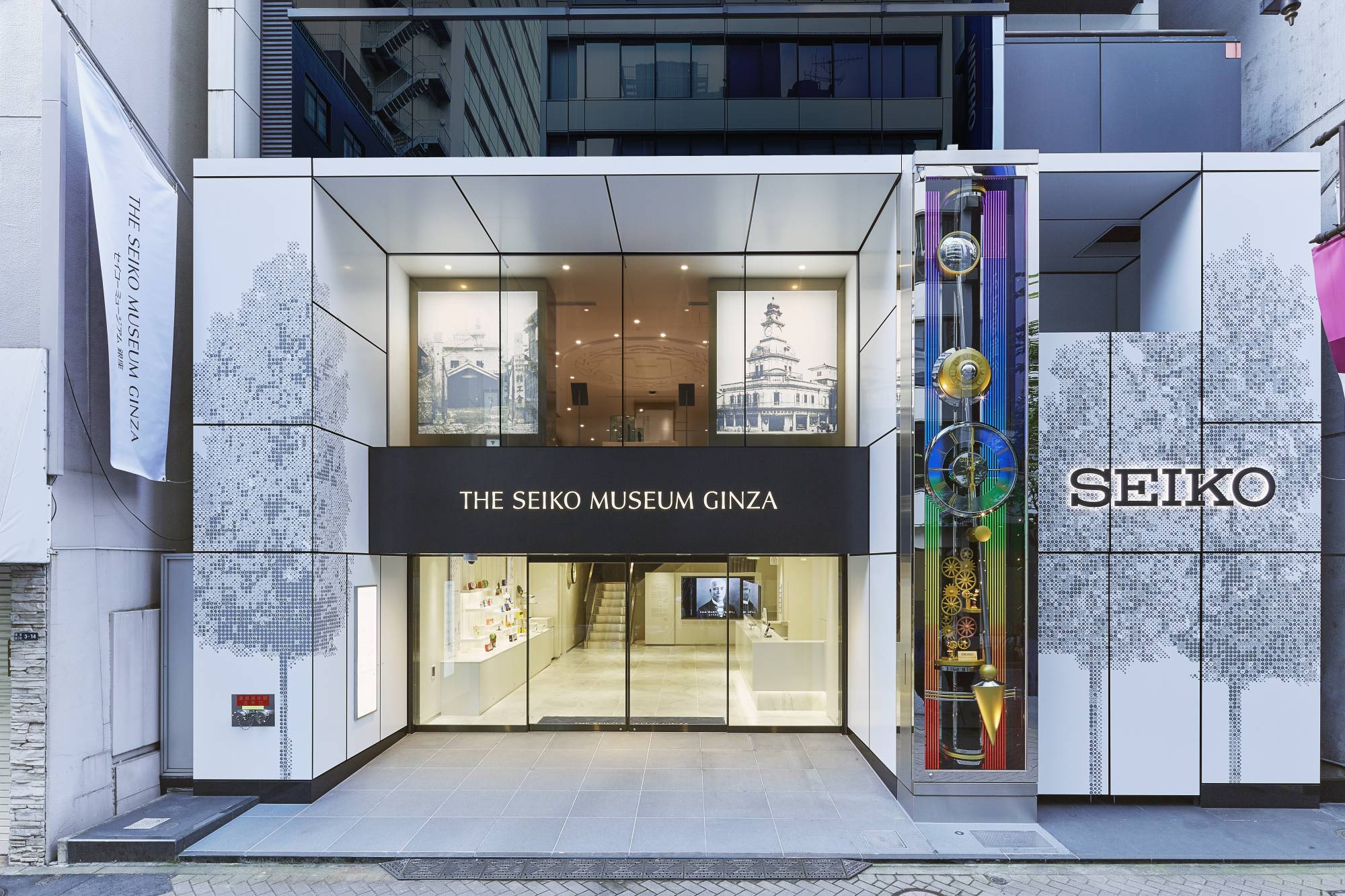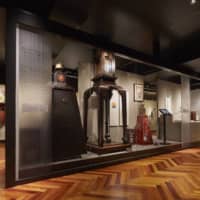At the grand opening of The Seiko Museum Ginza in that district on Aug. 19, one wonders whether company founder Kintaro Hattori, who initially established K. Hattori in Ginza back in 1881, was watching proceedings from above.
The horological museum has relocated from Sumida Ward to Ginza, the birthplace of Seiko. The museum’s opening, a 160th commemorative project for the esteemed timepiece manufacturer, sees the museum returning to the home of its founding.
“It had long been decided to move the Seiko Museum from Mukojima in Sumida Ward, to Ginza,” said Shinji Hattori, the founder’s great-grandson and group CEO, in an interview with The Japan Times in late 2019.
Rondeau clock
Of particular note is a striking 5.8-meter-high pendulum clock — “Rondeau La Tour” — decorating the new museum’s facade. Impressive in its stature, the street front timepiece makes a bold statement with the rhythmic and hypnotic electromagnetic movement of its pendulum, a synchronized performance between a pair of mechanical dolls and the movement of the clock’s cogs to mark each hour. A colorful light show to conclude the performance also draws attention.
The relationship between time and light is ever present, with filtered light being expressed in different ways according to the time of day and each of the four seasons.
The ambitious clock is the latest model in a series of large marionette or karakuri ningyō (mechanical doll) clocks developed in Japan by Seiko. The firm installed its first large-scale outdoor marionette clock, the Seiko Mullion Clock, in 1984.
Last year, Seiko unveiled a similar, but smaller, Rondeau Karakuri Clock in Ginza’s Wako Building. This karakuri (mechanism) timepiece also draws upon applications of clock technology. It evokes joy and wonderment among viewers through the use of automated dolls.
Museum history
The function of the original museum, established in 1981 as the Seiko Institute of Horology within the Seikosha factory (now Seiko Clock Inc.), was to make and preserve various research materials related to time and timekeeping instruments.
The museum housed thousands of watches and clocks, including traditional Japanese clocks or wadokei (Western clocks adapted to tell time in the traditional Japanese way). Visitors both young and old can learn about timekeeping instruments as seen through the evolution of time, view a chronology of Seiko product development and learn about sports timing instruments.
This museum was rebranded in 2012 as the Seiko Museum. Its rich and eclectic collection of historical timepieces was balanced with research activities and an increased emphasis on societal benefit and community engagement, such as holding workshops and events for children.
The Seiko Museum Ginza’s mission is to build upon such efforts. Not only is the museum a home for the group’s incredible collection of historical materials and a place to learn about horology, but it is also a place for engagement with diverse audiences that its new Ginza location provides.
Variety of attractions
Each floor within the new museum addresses a particular theme. Approximately 500 exhibits and presentations related to time and timepieces are on display. These include Seiko-specific exhibits, such as the second-floor Kintaro Hattori Room, a tribute to Seiko’s founder and lauded businessman who helped modernize the timepiece industry in Japan.
This floor is recommended as a highlight for visitors wanting to know more about the entrepreneur and philanthropist who was nicknamed, “King of Timepieces in the East.”

Also in the museum are the remains of a watch found in the wake of the Great Kanto Earthquake. At that time, Kintaro Hattori said he would replace the 1,500 or so timepieces his factory had slated for repair but were unfortunately destroyed during the natural disaster. This gesture received much attention.
However, the displays found here not only recognize Kintaro Hattori’s efforts as a successful businessman. This floor provides a fascinating prism through which to observe developments in Japanese craftsmanship, manufacturing, business and society, primarily during the early 20th century.
On the fourth and fifth floor, Seiko’s milestone products are displayed in chronological order, including numerous timekeeping firsts such as the world’s first quartz wristwatch named Astron in 1969 and Japan’s first wristwatch, Laurel, in 1913.

Global horological history
The third floor investigates the world’s horological history. Sundials and other ancient timepieces are used as starting points, as well as traditional wadokei clocks developed during the Edo Period (1603 to 1868).
Wadokei were created by Edo engineers to adjust Western clocks to the seasonal timekeeping system of the period. The museum boasts a comprehensive collection of wadokei and visitors can learn how the Japanese observed time some hundreds of years ago.
Sports timing

No mention of Seiko’s history is complete without acknowledging the outstanding contributions Seiko has made in precision sports equipment, from stopwatches to the latest in new camera technology, where distance can be measured as well as time.
Seiko’s sports timing history began in the 1960s when it presented an innovative hand-held stopwatch to the world athletic officials and then developed new equipment such as the world’s first portable quartz timepiece for use during sporting events. Visitors can see some of these at the museum, including actual starting blocks used in the World Athletic Championships, along with the trackside event board that shows the 9.58-second 100m world record, set in Berlin in 2009. Visitors can experience the timing at the finish line with equipment that is accurate to one-thousandth of a second.
Museum visitors can also see the firm’s most recent technological developments and experience the technology for themselves. They can also learn more about Seiko’s Start Information System, which tracks footplate pressure changes to gauge when athletes leave their respective starting blocks to detect false starts.
Also on show are the company’s sports watches, such as Seiko’s professional diver’s watches that boast excellent waterproof qualities. There is also a watch that Seiko designed specifically for use in space.
MUSEUM DETAILS
Name: The Seiko Museum Ginza
Location: Seiko Namikidori Bldg., 4-3-13 Ginza, Chuo-ku, Tokyo
Access: Tokyo Metro Ginza Station: 1 minute from Exit B2 or B4
JR Yurakucho Station: 4 minutes from Central Exit or Ginza Exit
Tel: +81-3-5159-1881
Opening hours: 10:30 a.m. to 6:00 p.m.
(Closed Mondays and New Year holidays); free admission
*Prior booking via internet required for one of three daily timeslots
Visit times: (1) 10:30 a.m. to 12:30 p.m., (2) 1 to 3 p.m., (3) 3:30 to 5:30 p.m.
Website: https://museum.seiko.co.jp







